Buying: Look for firm apples without bruising or soft spots. Preference on which variety to choose depends on personal taste for sweet, tart, or mild and what will be done with the apples - eaten raw, made into apple sauce, or cooked with which tart apples are best for retaining their shape and texture.
Storing:
Apples should be stored in a plastic bag, or uncovered, in the refrigerator or in a cool, dark place where they can retain their nutritional value for up to 3 months. Warm temperatures will make them lose their crispness. Like all refrigerated fruit, remove them from the refrigerator a couple hours before planning on eating them to restore their flavor. Bruised apples will release ethylene gas and cause other apples in the pack to exponentially ripen, so keep cut and bruised apples separate. If freezing cut apples, toss with powdered vitamin to reduce the browning and place on a baking sheet until hard, then store the frozen pieces in a tightly-sealed plastic bag. If not using the frozen apples within a few weeks, blanch them first.
Do not store apples with pears, onions, garlic or potatoes.
Medical: A medium apple is about 70 calories. It aids digestion and prevents fluid retention. High Vitamin C. Eating apple seeds is ok in small amounts, but in large amounts is dangerous as they contain a small amount of cyanide! The inflammatory and antioxidant nutrients in apples are good for decreasing asthma....where's my puffer?
Cooking: To prevent cut apples from browning when they are exposed to air, soak them in 2 tbsp lemon juice with 1/2 cup water. Browning just affects the appearance, not the taste.
Apples pair excellently with sharp cheddar cheeses and peanut butter.
The best apples to cook with that hold their shape well include Cortland, Empire, Jonagold, Northern Spy, and Rome. McIntosh will become fragile. As they are an early variety, Paula Red and Jersey Red are best for eating fresh off the tree, uncooked.
Thoroughly wash apples before use.
All About Apple Varieties
Braeburn – Originally from New Zealand, introduced in 1950′s. Spicy and tart with a juicy, crisp texture. Holds well in cooking as well as being a great eating apple.
Cortland – large sized apples with mostly red skin and red strips appearing on the lighter areas. They have a mild, tender flavor. Ideal for snacks, salads, and fruit platters because the flesh will remain white even after being cut. They are also good for baking with.
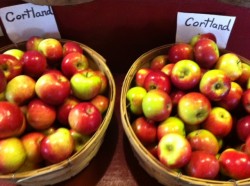
Empire – Native to New York, it is grown almost entirely on the East Coast. It is a cross between McIntosh and Red Delicious. Medium sized. Distinctive strips. They are great eaten raw, especially right from the orchard. They are good for baking and for making applesauce. The flavor is sweet and the creamy flesh is semi-firm.
Fuji – originally from Japan, it was introduced to the US in the 1980’s and it is now the fourth most widely grown in the US. Large sized. Sweet and crisp. Varies from golden to blushed pink. Holds its shape and texture well when cooked and also stores well.
Gala – originally from New Zealand, it was introduced to the US in 11965 but didn’t become popular until the 1980’s. It is now the third most widely grown in the US. Golden with pinky stripes. It is aromatic and tart. It holds its shape when cooked and great in applesauce. As one of the first harvested apples, it doesn’t keep very well, so don’t buy after early spring.
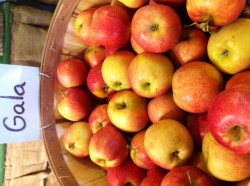
Golden Delicious – Medium to large sized. Golden yellow in appearance with a elongated shape and a five point bump at its base. The sweet flesh is yellowish-white and crisp. It is good for both eating and cooking.
Honey Crisp – Native to the US. Red skin with a golden background. Crisp and sweet. Good for eating fresh but also holds well during cooking.
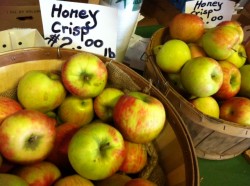
Ida Red – Native to the US. Good for eating fresh. Great for pies and their texture holds well in baked apple desserts. Sweet and tart flavor.
Jerseymac – a month-early variety of McIntosh. Medium to large size. Uniform shape. The skin is red with green slashes. Good for eating, but not great for baking.
Jonagold – native to New York. It is tangy. It is a bit soft to eat out of the hand, but it is creamy when cooked.
Macoun - from New York. Bright red with purple blush. Firm and juicy with a sweet white flesh. Great for eating fresh in salads or with cheese.
McIntosh – From North America. Medium to large sized. White flesh is sometimes lined with red veins. Skin is greenish with bright red blush. Slightly tart flavor. They bruise easily as they are tender, but can be stored for 2-3 months in cold storage. They are good to eat or baked in pies and sauces.
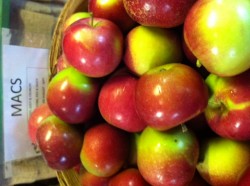
Milton – From the US. Medium sized. Yellow/green with red blush. Firm and Tart. Good for cooking apple sauce and baking pies.
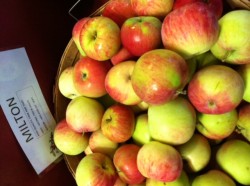
Mutsu – also called Crispin. From Japan. Large and green, it looks almost like a Golden Delicious. Sweet and sharp. Good for eating fresh, holds its shape well for cooking, especially baked apples.
Paula Red – From the US. Bright red. Early season variety. Small to medium sized. Mild taste. Good for eating fresh. Flesh becomes soft when cooked so it’s better for applesauce.
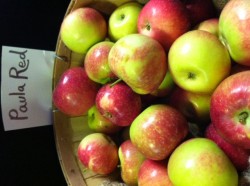
Pink Lady – A trademark name, the variety is actually Cripps Pink. One of the first apples marketed as its brand name rather then variety. From Australia. As the name suggests, the skin is delicate pink. Sweet, honeyed and tart. Best for eating fresh.
Red Delicious – Used to make up almost half of the American apple harvest, but now is only a little more than a quarter. Medium to large sized. Bright red, sometimes with stripes, and have distinctive bottom bumps. Crisp and sweet. Best eaten raw straight from your hand, and is not recommended for cooking.